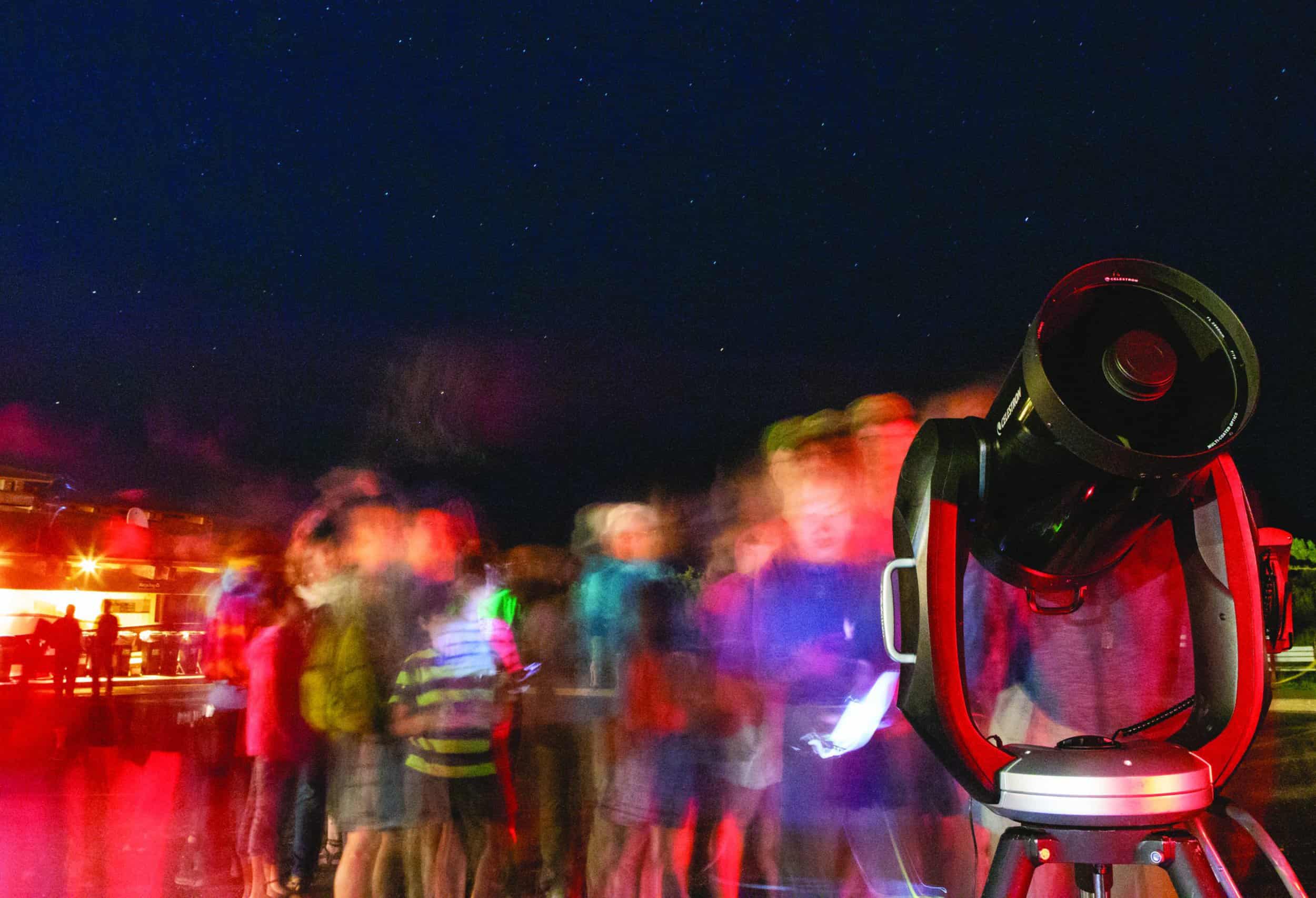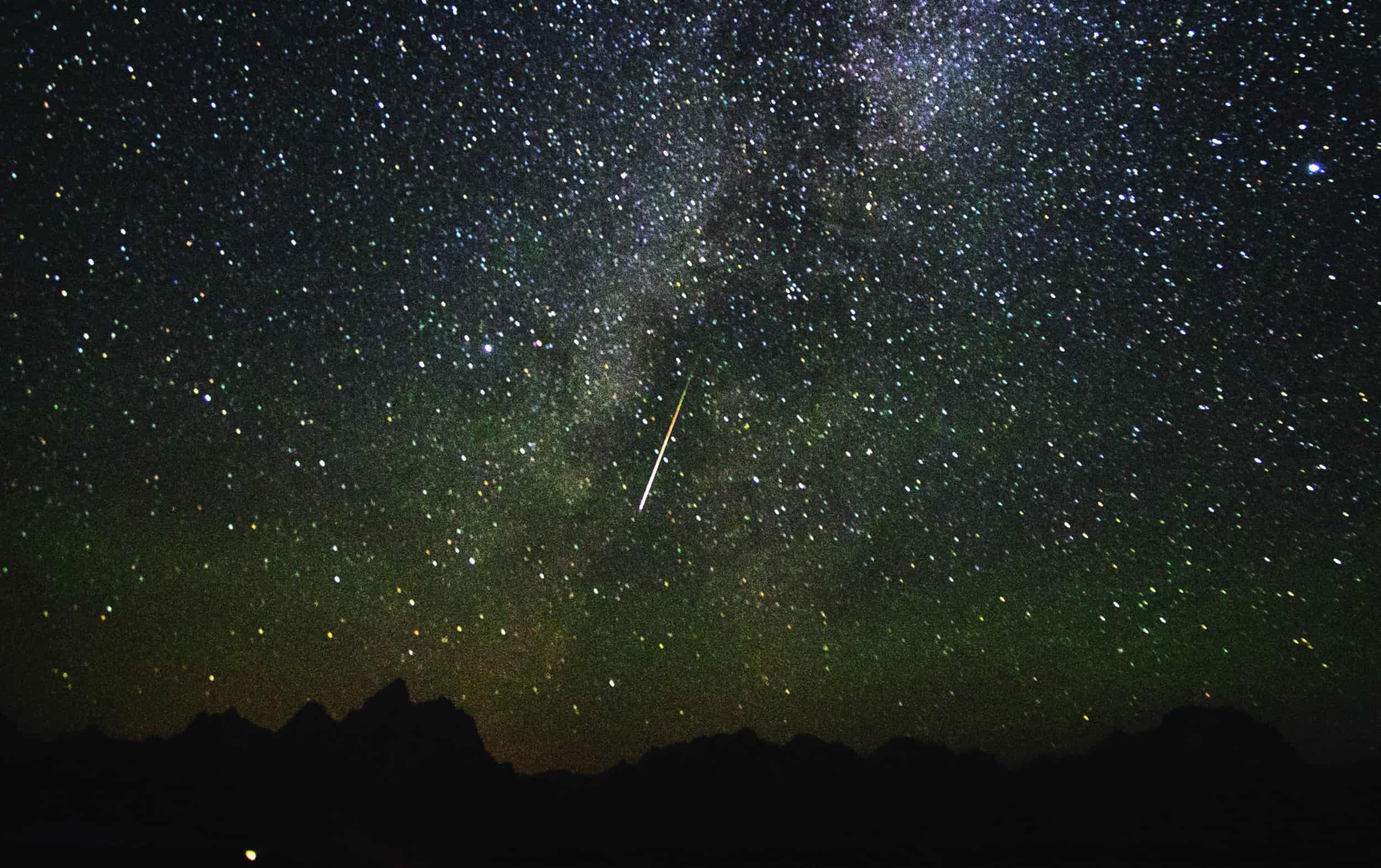Read The
Current Issue
Star Power
The dark skies of Jackson Hole are perfect for stargazing.
// By Samantha Simma

On a clear and moonless night on Antelope Flats, the sky overhead is an inky navy dotted with dense smatterings of stars and the hazy-yet-colorful expanse of the Milky Way galaxy. The western horizon is jagged with the snaggled outline of the Tetons, while, to the east, the skyline rolls away to the mellower Gros Ventre mountains.
According to Italy’s Light Pollution Science and Technology Institute, four out of five Americans cannot see the Milky Way, the 100 billion-star galaxy to which our solar system belongs, from their homes. In Jackson Hole, you can see the Milky Way, and thousands of other celestial objects. “We have some of the darkest skies of anywhere in the country,” says Samuel Singer, who, in 2013, founded Wyoming Stargazing, which leads nightly stargazing safaris around Grand Teton National Park. “A few places are darker—national parks in the Southwest, which have drier air and are father from cities—but Jackson Hole still has amazingly dark night skies.”
Besides lacking the levels of light pollution that plague metropolitan areas, Jackson Hole’s high elevation allows observers to view celestial objects through less atmosphere than in areas closer to sea level. Adding to this recipe for ideal stargazing conditions, our dry mountain air doesn’t bend the light given off by these objects like the water vapors in more humid air does. In the winter, stargazing conditions are at their best: “The colder air holds less moisture so the sky is crisper and more stable,” Singer says.
“A few places are darker—national parks in the Southwest, which have drier air and are father from cities—but Jackson Hole still has amazingly dark night skies.”
—Wyoming Stargazing founder Samuel Singer
Singer, whose father introduced him to stargazing, got his first telescope at age 10. However, it was the film Telescope Building with John Dobson (see sidebar), which Singer saw in his first astronomy class as a junior in high school, that made him passionate about the night sky. Before he graduated from high school, Singer started to build his own telescope—a Dobsonian telescope with a 14.5-inch mirror that alone took 200 hours to grind and polish; it took Singer another 200 hours to build the mount. Singer completed the telescope while an undergrad at Hampshire College in Amherst, Massachusetts. Once finished, he took to setting it up around campus and inviting other students to have a look through it. (Not surprisingly, Singer became known as “the telescope guy.”) It was while introducing fellow students to the night sky that he realized how much he enjoyed teaching. After graduating from Hampshire College, Singer went to graduate school at the University of Wyoming and earned a PhD in science education in 2013.
Participants in Wyoming Stargazing’s tours get to use much larger telescopes—with mirrors between 20 and 25 inches in diameter—than the one Singer made for himself. These are capable of viewing closer objects like the Moon and planets in detail and pick up on fainter, farther celestial objects like the spiral structure of Bode’s Galaxy. In the winter in Jackson Hole, you can see the Orion Nebula, the Gemini constellation, star clusters in Cassiopeia, the Andromeda Galaxy, and the Pleiades, or Seven Sisters star cluster, among other galaxies and constellations. “As the Earth orbits the Sun throughout the year, our nighttime faces out toward a different part of the universe,” Singer says. “So, the constellations and all the deep-space objects we can see change as we get a different perspective of the cosmos.”
John Dobson and Telescope Building
Having invented the Dobsonian telescope, amateur astronomer John Dobson shared the steps to build your own in the 1992 film Telescope Building with John Dobson, which is now available on YouTube. In just 90 minutes, you too can learn to create the original sidewalk astronomer’s invention. Dobson inspired amateur astronomers around the globe by making the activity more accessible via the portable, easy-to-use device he created. Before his death in 2014, Dobson made it his life’s work to travel the country and conduct public lectures and stargazing performances that were deemed “sidewalk astronomy.” Jackson’s own “telescope guy” Samuel Singer says of his work through Wyoming Stargazing, “I definitely consider myself part of his ongoing legacy.”
The Details
Each Wyoming Stargazing tour is private and customized to the group’s curiosities, from distant galaxies to the rings of Saturn or astrophotography. Tours with a stargazing leader are $500 for up to two people and $175/person for 3–13 people. A private stargazing tour with Singer is $750 for up to 3 people and $250/person for 4–13 people. A schedule of the organization’s public programs is available at wyomingstargazing.org, 844/WYO-STAR.
Jackson Hole Observatory
The goal of Wyoming Stargazing is to impact one million students via in-person and virtual programming by 2030. A key component of reaching this goal is the establishment of an observatory and planetarium at the summit of Snow King Mountain. Building of the facility started last summer. The facility will include a 20-foot AstroHaven dome and a research grade 1.0-meter PlaneWave telescope. Construction of the planetarium is projected to begin in 2023, with plans for it to include a 10-meter dome, 55 seats, and a state-of-the-art digital-projection system.
Stargaze on Your Own
You don’t need a guide to enjoy our night skies. In the evening hours, any of the pullouts along Highway 287 north of the Jackson Hole Airport serve well as stargazing locations. On a clear night, common constellations can be seen with the naked eye and identified with the aid of a star chart or an app like Star Walk. You don’t necessarily need to commit to a telescope right away. Using a pair of binoculars like the C.3 12×50 ($425), built by Lander-based Maven Outdoor Equipment, will bring thousands of faraway objects into clearer view including the Moon’s craters. If you’re interested in seeing more, like the rings of Saturn and Jupiter’s cloud bands, the Orion SkyQuest XT8 ($599) is a good entry-level telescope option.

Time Travel
A telescope is equal parts magnifying device and time machine. Light takes time to reach our eyes—about one second for every 186,000 miles. A light-year is the distance that light travels in one year—about 6 trillion miles—and is the unit of measurement for how far celestial objects are from Earth. The number of light-years away a star is located is also how many years it takes that star’s light to reach us. For example, Betelgeuse, Singer’s favorite star and the second-brightest star in the Orion constellation, is 642.5 light-years away. “Everything in the night sky, we can only see in the past,” Singer explains. “The farther away it is, the further back into the past we are seeing.” The light we see from Betelgeuse today left the star during the start of China’s Ming Dynasty and while the European Renaissance was in its infancy.
What to look up for this winter
GEMINIDS METEOR SHOWER – DECEMBER 13–14
At its peak, this meteor shower is expected to produce 120 meteors per hour.
QUADRANTIDS METEOR SHOWER – JANUARY 3–4
This year is good for the Quadrantids because of an early-setting crescent moon. Expect up to 40 meteors per hour.
MERCURY ELONGATION – FEBRUARY 4
Mercury reaches its highest point above the horizon just before sunrise.
MAKEMAKE AT OPPOSITION – MARCH 28
Just after dusk, the dwarf planet Makemake will be visible about 22 degrees above the eastern horizon; it reaches its highest point (69 degrees above the southern horizon) around midnight. JH
Time from the Earth to:
The Moon
1.3 light seconds
Mars
4.35 light minutes
The Sun
8.32 light minutes
The center of the Milky Way
26 thousand light-years
The North Star (Polaris)
320 light-years
Bode’s Galaxy
12.5 million light-years
Whirlpool Galaxy
25 million light-years JH





